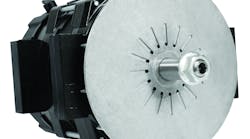Over the years, the role of the starter and alternator in heavy duty vehicles hasn’t changed. The starter converts the energy from the alternator to start, or crank over, the engine, while the alternator plays two roles. The first is to provide power to the vehicle’s electrical functions such as the stereo or lights. Secondly, the alternator keeps the battery charged. Though the basic function of the starter and alternator has remained the same, improvements have been made to these components.
Improvements such as higher output and remote sensing for the alternator, and an attached relay for the starter, as well as better life expectancy and a smaller and lighter design for both systems – while maintaining or reducing costs of the equipment – have been added, notes Orlando Braga, supervisor, electrical components engineering, Denso Products & Services Americas, Inc. Denso produces thermal, powertrain, mobility, electrification, and electronic systems for vehicles.
The industry is constantly looking for ways to upgrade equipment and systems for better performance, reliability, and power. While improvements made to starters and alternators have done just that, the industry is continually looking for further improvements and a way to meet the increasing demand being put on vehicles’ electrical systems. Specifically, the next step may be an increased vehicle system to 48V, and possibly higher.
48V systems, coming soon?
At this point in time, the United States transportation industry uses mainly 12V electrical systems in their vehicles, with some vehicles using a 24V system. Increasing the electrical systems from 12V and/or 24V to 48V is not as simple as, say turning the knob to increase the volume on a radio. Changes to system voltage will have an impact on other vehicle systems and processes, including updates to maintenance procedures, additional technician training, and new service equipment. Before any of this can take place though, the minds of the fleets must change.
“There is a resistance in trying to get the industry to move to the higher voltages, and it all revolves around cost. [S]omebody needs to eat the cost to make the change, and nobody wants to be the guinea pig,” says Clive Harley, vice president of engineering, Prestolite Electric, Broad-Ocean Motors, a global manufacturer and supplier of alternators, starters, electrical equipment, and services to the transportation industry. “The only way those kinds of things change is with legislation. [W]hen the government steps in and says, ‘You will go forward.’ or ‘You will do this, otherwise you will incur penalties.’”
Though there currently is no legislation specifically for transitioning to a 48V system, Harley believes the greenhouse gas emissions standards could be the push the industry needs to stop talking about 48V systems and make them a reality.
“[B]y going to a 48V system, specifically on trucks, there are huge, huge cost savings that can be benefited,” Harley says, “… and those cost savings should offset the cost to change from the 12V systems to the 48V, or the 24V to 48V.”
Cost savings is just one of the benefits fleets could gain from transitioning to 48V electrical systems in their trucks.
“The purpose of creating higher voltage electrical systems is primarily for the ability to achieve higher requirements from the vehicle,” say Rodney Spangler, application engineering manager and Matthew Hedges, senior application engineer at BorgWarner, a supplier of vehicle engine and drivetrain components and parts. “Higher vehicle efficiencies will be the biggest benefit we will see in the new technology.”
As discussion continues on the implementation of higher voltage systems, there has been some talk about the future design of starters and alternators.
The components within the electrical system such as the starter and alternator are likely to have a smaller and lighter weight design. This is in part due to thinner wires, notes Denso’s Braga.
“When you increase the voltage,” Braga says, “you reduce the current, hence thinner wire.”
Using a thinner wire is also more environmentally friendly. Less wire being used for those components means less usage of finite resources such as copper, Harley points out.
While internal structure may change, Spangler and Hedges suggest the size of the systems will remain similar to today’s starters and alternators.
“Physical size of both the starter and the alternator will stay roughly the same,” they suggest. “However, internal components will change depending on the voltage required.”
At this point, however, any changes in design are only speculation. Every OEM seems to have a different strategy on what the future holds for electrical systems, notes Harley. Some aren’t looking to make any changes while others are looking to go beyond 48V systems to 300V, or even 700V systems. Just implementing and designing the electrical components (starter, alternator, etc.) could take years or even decades, notes Braga.
“The major drawback for truck and component manufacturers and their customers would be the cost [of] changing to a higher voltage system,” Braga says. “Designing and testing new components would be expensive for customers buying new trucks with a higher voltage system while keeping older trucks with 12V system[s]. There may also be a difficulty in keeping and buying replacement parts and training their technicians.”
Along with updating maintenance training for technicians on these higher voltage systems, safety training will need updating as well. The higher the voltage system, notes Harley, the more dangerous it becomes for the technicians maintaining these systems.
The role of the technician
As technology changes, it makes sense that technicians adapt along with it. That means when the industry does implement these higher voltage systems to meet the increased demand on vehicles’ electrical systems, technicians must be properly trained and have the correct tools and equipment necessary to service and maintain these systems.
Training
Training for technicians on how to service starters and alternators in higher voltage systems mainly centers on safety.
According to Technology & Maintenance Council’s (TMC) Recommended Practice (RP) 1511, “There are three primary hazards associated with electricity: shock, arc, and blast. Shock is generally considered a hazard when working with voltages in excess of 50V. Arc and blast are generally considered a hazard when working with very high power, low-impedance power sources (e.g. utility substations).”
Though a 48V system is a bit below the shock hazard, that doesn’t mean technicians should take their safety lightly. Tools specific to electrical work and personal protective equipment should be used at all times when work is being done on an electrical component.
Additionally, when servicing high-voltage electrical systems, TMC’s RP 1511 notes technicians should use any lock-out or tag-out systems, tools, and processes. RP 1511 defines a lock-out as “the placement of a device on a piece of equipment to ensure that the unit cannot start-up unexpectedly,” and a tag-out as “the placement of a device on a piece of equipment to warn others that the machine or hazardous energy sources must not be operated under present conditions.”
In addition to safety, technicians will require training on proper maintenance and procedures for starters and alternators in higher voltage systems.
“For the starter, the most important maintenance is maintaining a clean and proper torque at all electrical connections. Moving to a 48V starter does not have any impact on this,” BorgWarner’s Spangler and Hedges say. “For the alternator, the inspection of the electrical connections, battery tests, visual inspections for debris, [and] pulley clamp loss (or proper belt tension) are essential for maintaining the life of the alternator.”
Additionally, they note, “for 48V systems, some alternators will require additional cooling, and for this, there will likely be an additional cooling loop to maintain.”
Maintenance for the starter and alternator will also depend on the design of the electrical system OEM’s decide on. It is possible there may be more electrically driven components than mechanically driven components in the 48V system, Spangler and Hedges say, meaning technicians will need a greater electrical knowledge.
It should also be noted, Denso’s Braga says, “When you increase the voltage system, components will experience greater electrical stress and will likely wear out faster. Technicians will likely have to change their service interval and check the start/charge system more frequently.”
Tools and Equipment
As for the tools and equipment necessary for maintenance of the starters and alternators in higher voltage electrical systems, there, again, may not be too much of a change from the tools and equipment needed to service current voltage systems.
“For 48V systems, there may or may not be new tools required to properly troubleshoot depending upon the complexity of the system,” Spangler and Hedges say. “Most handheld [digital multimeters] and amp clamps are capable of reaching 48V, but there will definitely be a shortage of automated diagnostic tools designed to troubleshoot 48V systems.”
Ultimately, as long as the technician’s tools are capable of reading and analyzing the electrical components within the higher voltage system, they should be able to properly service this equipment.
Conclusion
Overall, the future of starters and alternators within higher voltage electrical systems remains uncertain. The best way for fleets to prepare for the potential shift to higher voltage systems is to stay aware of the conversations happening throughout the industry and keep their technicians up-to-date on all safety and maintenance procedures for the systems, as well as provide them with the necessary tools and equipment for servicing.




